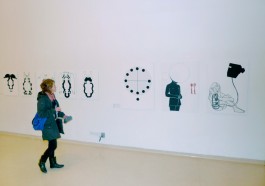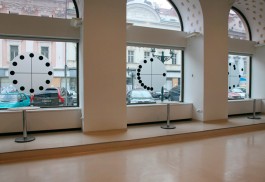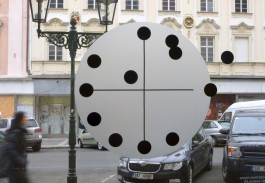A Centimeter a Day
06. 01. – 28. 01. 2012, České Centrum, Praha, CZ



In their exhibition A Centimeter a Day Lena Knilli and Jana Kasalová explore the notion of time and a life of changes, movements and our need (perhaps mistaken) to physically mark and map these.
In one series of work, Knilli recreates the old public clock faces of Prague which were discarded during her time in Prague. These were simple, round, white plexiglass clock faces made up of black circles indicating the hours and a cross in the middle. In their pure and distilled nature, these clock faces visualize our need to divide our lives into clean segments of activity over time, to order what is normally not so easily and definitively delineated. In Knilli’s version of the clock faces, the clock hands are missing so the clock faces only show potential positions and time situations and the circle marks (the hours) are moved from their given places towards or away from one another - time flows but irregularly and subjectively. The clock circles are replicated again on Knilli’s flowing skirts, a recurring theme in her work – the life of objects we surround ourselves with and the clothing we wrap ourselves in. These mark our time here just as surely as the clock but in not such a linear fashion. The circle marks change their position through the various movements and folds - we move forward but also borrow and constantly reference the past.
Kasalová, for her part, focuses on our location in time. She takes existing commercial maps and deconstructs them, cuts them into new shapes and configurations. What was seen as defined and clearly outlined is no longer so – she blacks out the names of places as these change over time. The maps become receptacles for abstract shapes which no longer help us find our way. Kasalova is particularly interested in the area of the Sudetenland at today’s Czech Austrian border where the names of particular places are or were known in one language or another, have multiple identities or in some cases no longer exist at all. Over the past few years, Kasalová has been creating a new kind map by charting the movements of animals but these are not maps which impose a way of seeing things and a way of moving, rather they are one of many possibilites created by instinct and not by conscious design. Like Knilli, Kasalová ask us to see the uncertain and fleeting nature of time and place and ultimately, to try to embrace this.
A Centimeter a Day
06. 01. – 28. 01. 2012, České Centrum, Praha, CZ



In their exhibition A Centimeter a Day Lena Knilli and Jana Kasalová explore the notion of time and a life of changes, movements and our need (perhaps mistaken) to physically mark and map these.
In one series of work, Knilli recreates the old public clock faces of Prague which were discarded during her time in Prague. These were simple, round, white plexiglass clock faces made up of black circles indicating the hours and a cross in the middle. In their pure and distilled nature, these clock faces visualize our need to divide our lives into clean segments of activity over time, to order what is normally not so easily and definitively delineated. In Knilli’s version of the clock faces, the clock hands are missing so the clock faces only show potential positions and time situations and the circle marks (the hours) are moved from their given places towards or away from one another - time flows but irregularly and subjectively. The clock circles are replicated again on Knilli’s flowing skirts, a recurring theme in her work – the life of objects we surround ourselves with and the clothing we wrap ourselves in. These mark our time here just as surely as the clock but in not such a linear fashion. The circle marks change their position through the various movements and folds - we move forward but also borrow and constantly reference the past.
Kasalová, for her part, focuses on our location in time. She takes existing commercial maps and deconstructs them, cuts them into new shapes and configurations. What was seen as defined and clearly outlined is no longer so – she blacks out the names of places as these change over time. The maps become receptacles for abstract shapes which no longer help us find our way. Kasalova is particularly interested in the area of the Sudetenland at today’s Czech Austrian border where the names of particular places are or were known in one language or another, have multiple identities or in some cases no longer exist at all. Over the past few years, Kasalová has been creating a new kind map by charting the movements of animals but these are not maps which impose a way of seeing things and a way of moving, rather they are one of many possibilites created by instinct and not by conscious design. Like Knilli, Kasalová ask us to see the uncertain and fleeting nature of time and place and ultimately, to try to embrace this.
About
Publications:
- NOW TO BUY: Zu Tisch! Ein Lesebuch für Krisenzeiten.
- Radio im Kopf
- Insights
Work Selection:
Exhibitions:
- 2025
- Book presentation: ZU TISCH! Ein Lesebuch in Krisenzeiten. Künstlerhaus (Salon), Wien, AT (greeting: Günther Oberhollenzer (Artistic Director, Künstlerhaus); conversation with Johannes Rauchenberger (Curator and Author, KULTUM Graz) and Lena Knilli).
- Book presentation: ZU TISCH! Ein Lesebuch in Krisenzeiten. KULTUM (Cubus), Graz, AT (conversation with Johannes Rauchenberger, Fatima Naqvi (Author) und Lena Knilli).
- Gott hat kein Museum. KULTUM, Graz, AT in cooperation with steirischer herbst 25.
- CONNECTED IV. Galerie Hollar, Prague, CZ (curated by Martin Lohnicky).
- 2024
- Feminology. Archaeological Museum, Zagreb, HR & Galerie Hollerei, Wien, AT (curated by Tanja Prušnik & Sandra Stanaćev Bajzek).
- KUBUS III. Künstlerhaus Factory Wien, AT (curated by Anke Armandi, Maria Grün & Lena Knilli, Maria & Knilli, Lena).
- Den Blick öffnen, Art p, Perchtoldsdorf, AT.
- Kunst trotz(t) Ausgrenzung. Wanderausstellung der Diakonie Deutschland (2018 – 2024). Städtische Galerie Speyer; Museumsverband Nordfriesland, Husum; Societät Rostock Maritim e.V.; Kunsthalle Recklinghausen; Berlin; Stuttgart; Chemnitz; Hannover; Osthofen; Kassel & Braunschweig, DE (curated by Andreas Pitz).
- 2023
- Connected III. Künstlerhaus Factory, Wien, AT (curated by Martin Lohnicky).
- VERGESSEN / ZAPOMNĚNÍ. Wanderausstellung (2021 – 2023). Galerie Klatovy Klenová, zámek Klenová, CZ; Österreichisches Kultur Forum, Praha, CZ; Städtische Galerie Lehrte, DE & Künstlerhaus Factory, Wien, AT (ein Projekt mit Jana Kasalová).
- 2021
- 2020
- HOCHsommer 2020 – Die steirische Breite III. GerberHaus, Fehring, AT.
- Šest pohlednic. Dům umění, Brno, CZ.
- 2019
- Ich bin eine ewige Wahrsagerin (Maria Lassnig und ihre Schüler*innen). Galerie Freihausgasse, Villach, AT.
- 2017
- 2016
- Meeting Maria. Städtische Galerie Lehrte, DE.
- Luther reicht nicht. Kunsthalle Kaufbeuren, DE.
- Zum Fressen Gern. Benediktinerstift Admont, AT.
- Zu Tisch! Bundesministerium für Bildung, Wien, AT.
- Lena Knilli. Galerie Otevřená Zahrada, Brno, CZ.
- 2015
- BRENNENDE FRAGEN – ÜBER: MACHT. Künstlerhaus, Wien, AT (curated by Ilse Chlan & Maria Christine Holter)
- reliqte reloaded. KULTUM, Graz, AT (curated by Johannes Rauchenberger).
- GELB. Aktuelle Positionen österreichischer Kunst. BIG gallery, Dortmund, DE.
- 2014
- TIME(LESS) SIGNS. ACFL, London, UK (curated by Christopher Burke & Maria Christine Holter).
- Drawings II. Galerie Schafschetzky, Graz, AT
- 2013
- Seelenwäsche. KULTUM, Graz, AT (curated by Johannes Rauchenberger).
- 500+1. Das Gewand als Motiv zeitgenössischer Kunst. Museum am Dom Trier, DE.
- fuzzy.family. NÖart Wanderausstellung, AT.
- Zeichnen Zeichnen. Künstlerhaus Wien, AT (curated by Fridolin Welte & Natalia Weiss).
- Cesta do Zahrady. Galerie Kabinet_Chaos, Střítež, CZ.
- 2012
- 2010
- Haare. Kunsthandel Wolfrum, Wien, AT.
- Mutter. KULTUM, Graz, AT.
- Spuren/Vorgaben. České Centrum, Wien, AT.
- Věno. postava. čas. Galerie Caesar, Olomouc, CZ.
- 2009
- About myself. Galerie Hunt Kastner, Praha, CZ.
- 2008
- Students of Maria Lassnig. Heiligenkreuzerhof, Wien, AT.
- 2007
- Camping III. kunstMarke, Wien, AT (ein Projekt mit Cornelia Foerch).
- Nackt. Galerie Wolfrum, Wien, AT.
- In preparation: Camping IV. Estavayez–le–lac, CH (ein Projekt mit Cornelia Foerch).
- Consider this. Haac, Holland, MI, USA.
- 2006
- Camping II. La Corbiere, Village Nomade, Estavayez-le-lac, CH (ein Projekt mit Cornelia Foerch).
- Galerie Ars, Brno, CZ.
- In den Häusern. hunt kastner gallery, Praha, CZ.
- 2005
- Zuhause. Kornhäuselvilla, Wien, AT.
- 2004
- Galerie Wolfrum, Wien, AT.
- Flora versus Fauna. Galerie Wolfrum, Wien, AT.
- Lena Knilli, recent works. Arts Center, Winona, MN, USA.
- 2003
- 6,6% the inclined space. pogmahon artclub in the bakery Notz, Wien, AT.
- architektura kabatku. galeryje 9, Brno, CZ.
- Rozkvet kastanu. chapel Sv. Barbora, Buchlov, CZ.
- 2002
- Lost and Found. VCOE, Wien, AT.
- 2001
- Spekulatius. Hotel Altstadt, Wien, AT.
- 2000
- Melancholie. Moravská Galerie, Brno, CZ.
- Lena Knilli. Galerie Aspekt, Brno, CZ.
- 1999
- Obyčejné pohádky. Galerie U Bílého jednorožce, Klatovy, CZ & Galerie Emila Filly, Ústí nad Labem, CZ.
- Nový Zlínský Salon 1999. Státní Galerie, Zlín CZ.
- 1998
- Jenom Citron. Just Lemon. Galerie Malá špálovka, Praha, CZ.
- 1997
- Galerie E. Filly, Ústí nad Labem, CZ.
- Slike. Bežigrajská galerie, Ljubljana, SLO.
- 1996
- česká abstraHce. Galerie Václava Špály, Praha, CZ.
- Galerie Ruce, České Středisko, Berlin, DE.
- Něco se stalo. Galerie Aspekt, Brno, CZ.
- Rozhodně Ano! Galerie Ruce, Praha, CZ.
- 1995
- SOMA. Bethanien, Berlin, DE.
- Obrazy. Galerie Václava Špály, Praha, CZ.
- 1994
- Plavoucí krávy, installation on a lake. Jezírko v Prokpopském údolí, Praha, CZ.
- Loupání pomeranče a jiné obrazy. Exhibit in a forest, Chyňava, CZ.
- 1993
- Les 1An du Rayon Vert. Galerie Le Rayon Vert, FR.
- Mains publique, mains priveés. Galerie le Rayon Vert, Nantes, FR.
- 1991
- Sechs gemeine Bilder. Galerie CULT, Wien, AT.
- 1989
- Klasse Lassnig. Heiligenkreuzerhof, Wien, AT.
- Hand und Fuß. Neue Galerie, Graz, AT.
- 1988
- Die Produktion von Gut und Böse. Galerie A Canale, Wien, AT.
- 1987
- Joseph klopft. Augarten, Wien, AT.
- Die Anweisung. Berlin, DE.
- 140 x 110. Wien, AT.
- Schmerz. Konferenzzentrum, Hamburg, DE.
- 1986
- Öl auf Papier. Galerie Commune, Wien, AT.
Collections:
- Foundation for Contemporary Arts Prague
- Sammlung der Kulturabteillung der Stadt Wien MUSA
- KULTUMdepot Graz
Texts:
- Naqvi, Fatima (2023): Lena Knilli.
- Franke, Julienne (2022): ZAPOMNĚNÍ / VERGESSEN.
- Rauchenberger, Johannes (2010): Mutter.
- Knilli, Lena (2010): Dowry. věno.
- Kotik, Charlotta (2010): Kunst und Kirche.
- Knilli, Lena (2008 – 2009): Self Portrait.
- Gallery Hunt Kastner (2006): In den Häusern. V techto domech. In these homes.
- Le Quesne, Lizzy (2006): The secret lives of objects.